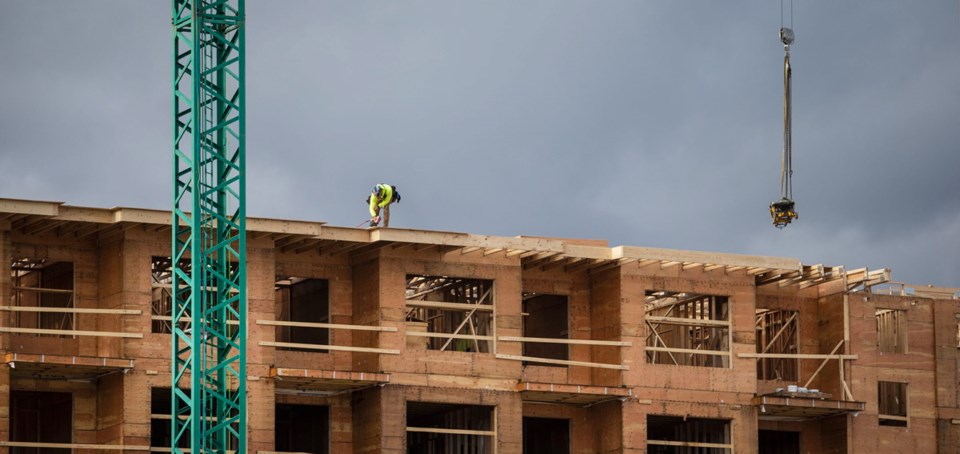The number of new homes being built in the capital region this year will fall behind 2017’s record high, but residential construction is still expected to remain strong.
Greater Victoria’s and B.C.’s housing markets are facing similar challenges and changes. The latest housing market forecast from Canada Mortgage and Housing Corp. points to factors such as fewer people moving to B.C. from other provinces, higher interest rates and stricter borrowing rules for buyers needing mortgages.
The report comes as the Chartered Professional Accountants of B.C. say in a business outlook survey that continuing labour shortages and high housing costs are the top challenges facing economic growth in the province.
B.C. has a five per cent unemployment rate, putting the province at near-employment capacity at the same time the demand for labour continues to rise, the survey said.
The accountants said housing affordability is the most pressing economic issue in B.C.
CMHC said that home prices in the capital region will not be rising as quickly as in the past, although they are still anticipated to move upward.
Hovering above any analysis of capital region housing is the question of affordability, whether it’s the ability to purchase a home or to rent.
The rate of construction for new rental units, over a multi-year period, is the highest seen since the 1970s, Canada Mortgage and Housing Corp. analyst Braden Batch said. It is being driven by the fact that the “vast majority of new households formed in Victoria are choosing to live in rental accommodation rather than their own home.”
This week, Victoria council members proposed measures to try to create more affordable housing.
One suggestion is to ask staff to recommend amendments to the city’s housing strategy and related bylaws and policies to “incentivize and mandate” creation of two- and three-bedroom rental units as part of a larger strategy to increase affordable housing options.
Another idea is to bring in an interim inclusive housing-density bonus policy as the foundation for negotiations with developers. Some councillors want any condo units being used as short-term vacation rentals to be designated as commercial by the B.C. Assessment Authority. Others are urging the city to acquire land for afforable housing.
At the same time, as CMHC predicts rents are expected to climb next year and the vacancy rate — even though it is rising — is forecast to be a tight one per cent this year, 1.5 per cent in 2019 and 1.8 per cent in 2020 That will be up from 0.7 per cent in 2017, the federal agency said.
Average monthly rent for a one-bedroom apartment in Greater Victoria is anticipated to move to $1,145 next year, from $1,065. That figure may seem below the rental market, but that is because it includes older units with lower rates, Batch said.
The main reason that the vacancy rate is poised to rise is new rental units coming onto the market, CMHC said.
Rental costs will move up not only because of the new units, but as older units turn over, rents for those homes will increase to catch up to the rest of the market, the agency said.
Total housing starts for this year, for market and rental units, are predicted to range between 3,400 and 3,800. Next year, CMHC expects between 2,700 and 3,100 units to be started.
Last year’s record tallied 3,862 starts — largely multi-family condos and apartments. Of those, 2,966 were multi-family and 896 were single-family.
The rate of growth in prices has backed off from double digits to single digit, CMHC said. As the increase in prices slows, “it is expected that production on higher-cost projects will also moderate.”
Inventory of higher-end homes has increased from a year ago. This coincides with the Victoria Real Estate Board saying the upper-end of the market has shown softness.
The relative affordability of condominiums appears to be driving low inventory in that segment of the market, CMHC said.
October’s benchmark price for a single-family house in the capital region was $765,300 while the benchmark for a condo was $495,600, according to the Victoria Real Estate Board.
Sales have declined “considerably” this year, CMHC said.
Higher sales numbers appear unlikely because of more modest predictions of growth for both population and employment, it said.
Even though price growth has slowed this year, it is still moving above inflation, CMHC said.
But the slowing in growth “will come from a shift to more condos as opposed to single-detached sales. “It is likely that condo prices will continue to rise, albeit at a slower pace, until more supply is introduced into the market over the next two years.”



